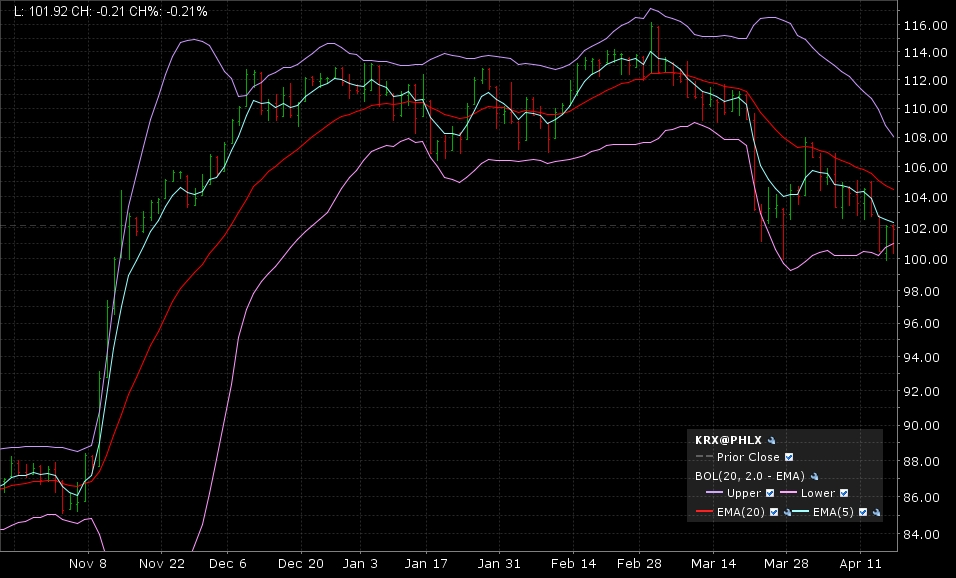Galloway: [talking through the batting cage fence] I don't think you're fit to handle the defense.
Kaffee: You don't even know me. Ordinarily it takes someone hours to discover I'm not fit to handle a defense.
A Few Good Men, 1992
We are knee-deep in earnings releases this week, so I will attempt, but probably fail, to be brief in this letter. The last few Miller’s Market Musings have garnered some comments, mainly along the lines of “that can’t really be true” variety, but, unfortunately, the data doesn’t lie. Since the March 5th letter, the KBW Regional Banking has fallen a touch over 10%, while the S&P 500 (SPX) fell just under 2%. But wait, the whole market rallied after the election on the reflation trade (aka, Trump Trade) of lower regulation and lower taxes, which would lead to higher inflation and therefore higher rates, helping the banks the most. But the banks are telling you the Trump Trade isn’t happening. Want to know what else is telling you that? Ten-year treasuries. The yield on the 10-Year had been bouncing between 2.30% and 2.60% since mid-December, before breaking down this week and closing at 2.18% today. Take a look at the charts of the 10-Year and the KRX below and tell me if you want to handle the defense of the reflation trade. I’ll wait.
Col. Jessup: [from the witness stand] You want answers?
Kaffee: I think I'm entitled to.
Col. Jessep: You want answers?
Kaffee: I want the truth!
Col. Jessup: You can't handle the truth!
A Few Good Men, 1992
Here’s the thing: if stocks were trading at reasonable valuations, or even average valuations, and individual investors had rational expectations for forward returns, and funds were being managed in a prudent manner by fiduciaries who were more concerned about capital preservation than they were about index replication, then we could handle the truth about likely future returns from financial assets these days. But none of the above are true today. Right now, fully 40% of assets in U.S. equities are in passive vehicles, up from 17% in 2005. Basically, a large portion of the U.S. investing base has bought into one of two basic narratives: 1) it is impossible to beat the market, so why bother trying or 2) markets never go down for long, so why bother studying them and making decisions about holding cash and hedging. I’ve been reading a lot of articles from folks who manage index strategies crowing about how over the long-term, indexing wins, when really, what they are falling for is a recency bias. There have been long periods of time when stocks produced painfully negative returns. If you have a client nearing retirement, or with upcoming spending needs, like college, blissfully ignoring the truth about where we sit today from a valuation and risk standpoint is reckless. Because the truth is, financial assets aren’t cheap, and you can be fairly certain that if we ever get a sharp, sustained correction again, a lot of that “long-term” money is going to freak at just the wrong time. That’s when you’ll find real bargains and good risk-reward setups to put cash to work. Right now just isn’t that time. Don’t believe me? Then check out this series of charts on valuation and positioning, and tell me how this ends well.
Right now we are solidly in the “Most Expensive Quintile” bucket of the above chart, with the most recent reading for the Shiller PE (admittedly, not my favorite measure, but its decent for broad views) at 28.94. The cutoff to be in the 5th quintile in the chart above for most expensive is 19.6x. The cheapest quintile ranges from 6.8x to 12.8x. So to get there, we’d have to fall over 55% to be just inside the band. To get to 6.8x, we’d need to fall over 76%. That’s just the truth of the math. The Shiller ratio was only higher than today in 1929 and 2000. But wait! Shiller uses backward looking, smoothed earnings, and earnings were terrible in the Great Recession. It’s also a terrible timing indicator, as it often continues to get more overvalued for years. Surely things will be better going forward, obviating the usefulness of all this history. Well, yes and no. Yes, Shiller includes some horrible earning years. But forward estimates are nearly as horrible at being accurate. Check out the following chart:
Earnings have a way of surprising – but not in a good way. Earnings peaked in 2014, and have been coming in lower ever since, despite optimism that they would get better. Think we’re going to finish the year with S&P 500 estimates at $147 per share? Yeah, me neither.
Over in the Matrix, we’re going to take a deeper look at flaws in ETF construction, what’s happening with consumer loans (hint: it’s not just auto loans that are in trouble), and many more stock specific ideas.
This week’s Trading Rules:
§ Sometimes the truth hurts. That doesn’t mean you should ignore it.
§ The only kind of danger is grave danger.
Money flows and interest rates drive the macro environment, which moves stocks in the short run. Long-term, valuation matters as well. Today, both are unfavorable for strong future returns. We ended our last letter with, “The market is fully-valued and is priced for Trump to get what he wants. We’re holding cash in case he, and the market, are disappointed. Now we’re also fully hedged and short high yield bonds. Can markets continue to power higher? Of course. But with hedging costs still very low, valuations extremely stretched, credit weakening in China (and in the U.S. in auto loans), at the same time the market structure is particularly fragile, not hedging would be irresponsible. Do the right thing. Get some hedges on.” I wouldn’t change a word.
SPY (NYSE:SPY) Trading Levels: Last time we wrote that “This little selloff has created some resistance just above the current price, with a lot more at 236 and then 238.” Since then, the market spent a lot of time struggling with the 236 level before breaking down recently. Overhead resistance is even stronger now, while support is weaker.
This week’s levels:
Resistance: A whole lot from 235 to 238, as the choppiness just under the 236 level has now become even more resistance.
Support: Same as before. 228/229 is the first level. Then a little at 221/222, then 218/219, then a lot at 213/215. After that it’s 209. That said, on a move of more than 2%, expect selling to accelerate as leveraged players get out.
Positions: Net neutral stocks (both long and short stocks). Short SPDR S&P 500 (NYSE:SPY), iShares iBoxx $ High Yield Corporate Bond (NYSE:HYG) and other ETFs. Long put options on SPY and other market ETFs.

